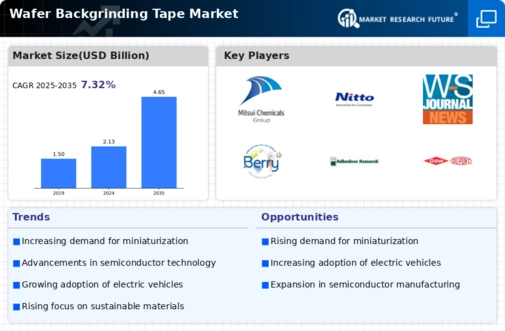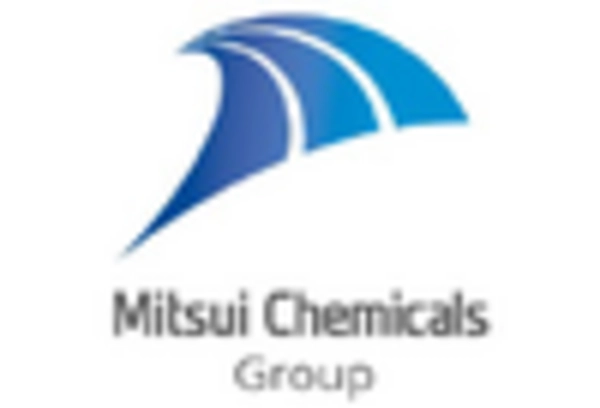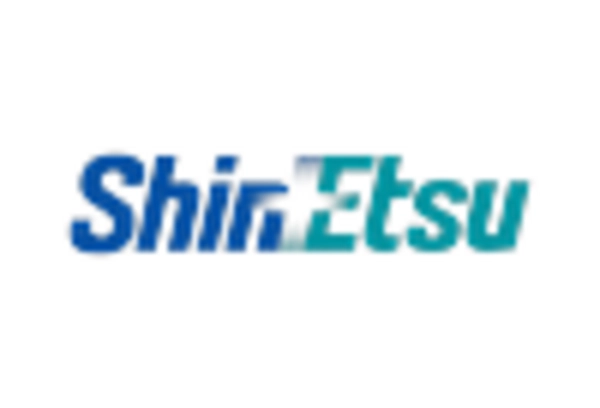Advancements in Material Science
Innovations in material science significantly influence the Wafer Backgrinding Tape Market. The development of new adhesive materials and tape formulations enhances the performance and efficiency of backgrinding processes. For instance, the introduction of high-temperature resistant tapes allows for better handling during the grinding process, which is essential for maintaining wafer integrity. As the semiconductor industry evolves, the demand for advanced materials that can withstand rigorous manufacturing conditions is likely to increase. This trend suggests that companies investing in research and development of new tape materials may gain a competitive edge, further stimulating growth in the Wafer Backgrinding Tape Market.
Expansion of Consumer Electronics
The continuous expansion of the consumer electronics market significantly impacts the Wafer Backgrinding Tape Market. With the proliferation of smart devices, including wearables, smart home products, and high-definition displays, the demand for advanced semiconductor components is on the rise. This growth is reflected in the expected increase in semiconductor sales, which could surpass 600 billion dollars by 2025. As manufacturers strive to meet this demand, the need for effective backgrinding solutions becomes critical. Wafer backgrinding tapes play a vital role in ensuring that these components are produced with the required precision and quality, thereby driving the growth of the Wafer Backgrinding Tape Market.
Rising Adoption of Electric Vehicles
The automotive sector's shift towards electric vehicles (EVs) is poised to impact the Wafer Backgrinding Tape Market positively. As EVs incorporate advanced semiconductor technologies for battery management systems and power electronics, the demand for high-performance wafers increases. This transition is expected to drive the semiconductor market, which is projected to grow at a compound annual growth rate of over 10% in the coming years. Consequently, the Wafer Backgrinding Tape Market stands to benefit from this surge in demand, as manufacturers require efficient backgrinding solutions to produce the necessary components for EVs. The integration of sophisticated electronics in vehicles necessitates the use of specialized tapes that can support the production of thinner, more efficient wafers.
Increasing Demand for Miniaturization
The trend towards miniaturization in electronic devices drives the Wafer Backgrinding Tape Market. As manufacturers strive to produce smaller and more efficient components, the need for thinner wafers becomes paramount. This demand is reflected in the projected growth of the semiconductor industry, which is expected to reach a valuation of over 500 billion dollars by 2025. Consequently, the Wafer Backgrinding Tape Market is likely to experience heightened demand as these tapes are essential for the thinning process, ensuring that wafers can meet the stringent requirements of modern electronics. The ability to produce high-quality, thin wafers is crucial for applications in smartphones, tablets, and other compact devices, thereby propelling the market forward.
Focus on Cost Efficiency in Manufacturing
The emphasis on cost efficiency in semiconductor manufacturing processes is a key driver for the Wafer Backgrinding Tape Market. As companies seek to optimize production costs while maintaining high-quality standards, the adoption of efficient backgrinding techniques becomes essential. This focus on cost reduction is likely to lead to increased investments in advanced backgrinding technologies and materials, including specialized tapes that enhance productivity. The potential for reduced waste and improved yield rates can significantly impact the overall profitability of semiconductor manufacturers. Therefore, the Wafer Backgrinding Tape Market is expected to witness growth as companies prioritize cost-effective solutions in their manufacturing processes.

















Leave a Comment